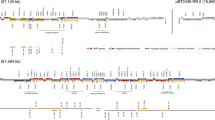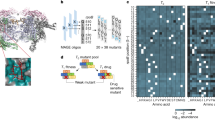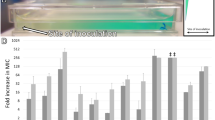Summary
The archaebacterium Halobacterium volcanii was found to be very sensitive to the antifolate drugs trimethoprim and methotrexate. Resistant mutants arise spontaneously at a frequency of 10-10–10-9. The following evidence is presented which correlates the spontaneous resistance to gene amplification: (a) all resistant mutants have readily observable amplified DNA sequences; (b) the amplified DNA shares common sequences; (c) resistant mutants revert at high frequency to sensitivity, at the same time losing the amplified sequences; (d) there is a genetic linkage between the resistance to trimethoprim and the amplified DNA sequences; (e) all resistant mutants overproduce a 20 kDa protein that corresponds in size to the enzyme dihydrofolate reductase the target of the drugs.
Similar content being viewed by others
References
Alt FW, Kellems RE, Bertino JR, Schimke RT (1978) Selective multiplication of dihydrofolate reductase genes in methotrexate-resistant variants of cultured murine cells. J Biol Chem 253:1357–1370
Anderson RP, Roth JR (1977) Tandem genetic duplication in phage and bacteria. Annu Rev Microbiol 31:473–504
Dennis PP (1986) Molecular biology of archaebacteria. J Bacteriol 168:471–478
Fox GE, Stackebrandt E, Hespell RB, Gibson J, Maniloff J, Dyer TA, Wolfe RS, Baltch WE, Tanner RS, Magrum LJ, Zablen LB, Blakemore R, Gupta R, Bonen L, Lewis BJ, Stahl DA, Luchrson UR, Chen KN, Woese CR (1980) The phylogeny of prokaryotes. Science 209:457–463
Haber DA, Beverley SM, Kiely ML, Schimke RT (1981) Properties of an altered dihydrofolate reductase encoded by amplified genes in cultured mouse fibroblasts. J Biol Chem 256:9501–9510
Maniatis T, Fritsch EF, Sambrook J (1982) Molecular cloning. Cold Spring Harbor Laboratory, Cold Spring Harbor, New York
Mevarech M, Werzcberger R (1985) Genetic transfer in Halobacterium volcanii. J Bacteriol 162:461–462
Schimke RT (1984) Gene amplification in cultured animal cells. Cell 37:705–718
Sirotnak FM, Moccio DM, Kelleher LE, Goutas LJ (1981) Relative frequency and kinetic properties of transport defective phenotypes among methotrexate-resistant L1210 clonal cell lines derived in vivo. Cancer Res 41:4447–4452
Thomas JO, Korenberg RD (1975) An octamer of histones in chromatin and free in solution. Proc Natl Acad Sci USA 72:2626–2630
Tlsty TD, Albertini AM, Miller JH (1984) Gene amplification in the lac region of E. coli. Cell 37:217–224
Author information
Authors and Affiliations
Additional information
Communicated by A. Böck
Rights and permissions
About this article
Cite this article
Rosenshine, I., Zusman, T., Werczberger, R. et al. Amplification of specific DNA sequences correlates with resistance of the archaebacterium Halobacterium volcanii to the dihydrofolate reductase inhibitors trimethoprim and methotrexate. Mol Gen Genet 208, 518–522 (1987). https://doi.org/10.1007/BF00328149
Received:
Issue Date:
DOI: https://doi.org/10.1007/BF00328149




